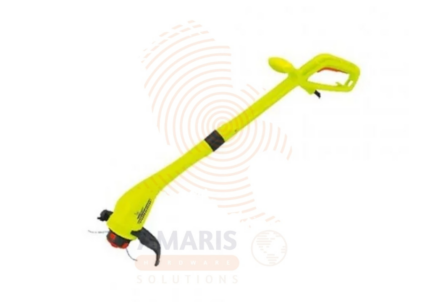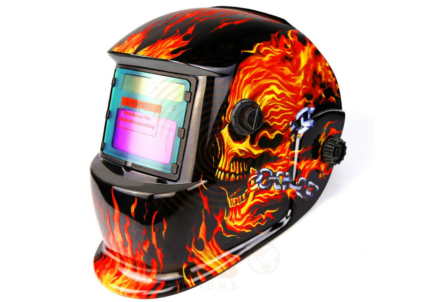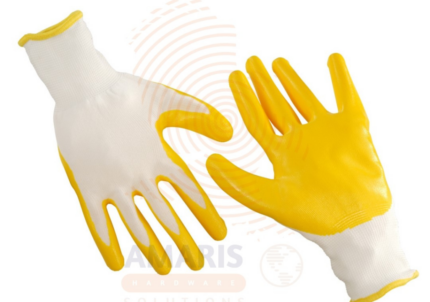Back to products


Electric Brush Cutter
$30.77 Original price was: $30.77.$29.23Current price is: $29.23.
Ear Muff
WhatsApp Order
Ear muffs are a type of personal protective equipment designed to cover and protect the ears from noise, cold weather, or both. Typically consisting of two padded ear cups connected by a band that goes over the head, ear muffs are worn to reduce the intensity of loud sounds and to provide insulation against cold temperatures, ensuring the wearer’s comfort and safety in various environments.
Description
Uses of an Ear MUFF
- Hearing Protection in Industrial Settings: Workers in noisy environments, such as construction sites, factories, or manufacturing plants, use ear muffs to protect their ears from prolonged exposure to loud machinery and equipment.
- Occupational Safety: Professionals in sectors like aviation, forestry, and landscaping wear ear muffs to safeguard against the noise generated by aircraft engines, chainsaws, and other loud equipment.
- Shooting and Hunting: Ear muffs are often worn by shooters and hunters to protect their ears from the loud sounds of gunfire, helping prevent hearing damage caused by repeated exposure.
- Concerts and Entertainment Events: Attendees at concerts, music festivals, and other live events use ear muffs to reduce the impact of loud music and prevent potential hearing damage.
- Recreational Shooting and Sports: Individuals engaging in recreational shooting, as well as participants in sports with loud noises (such as motorsports), use ear muffs to protect their hearing.
- Sleeping and Noise Reduction: Some people use ear muffs while sleeping to block out ambient noise, promoting a more restful sleep environment.
- Cold Weather Protection: In addition to their role in hearing protection, ear muffs with insulation properties are commonly worn in cold weather to keep the ears warm.
- Airport Ground Crews: Workers on airport tarmacs and runways wear ear muffs to protect their ears from the noise generated by aircraft engines during takeoff and landing.
- Motorcycling: Motorcyclists may use ear muffs to reduce wind noise and protect their ears from the loud sounds associated with riding at high speeds.
- Concentration and Study: Some individuals use noise-canceling ear muffs to create a quiet and focused environment for studying, working, or concentrating in noisy surroundings.
SAFETY HANDLING PRECAUTIONS
- Proper Fit:
- Ensure that the ear muffs fit snugly over your ears, forming a tight seal. Loose or improperly fitted ear muffs may not provide adequate protection.
- Correct Type for the Environment:
- Choose ear muffs with the appropriate Noise Reduction Rating (NRR) for the specific environment in which you are working. Different settings may require different levels of noise protection.
- Regular Inspection:
- Inspect ear muffs regularly for any signs of wear, damage, or deterioration. Replace them if you notice cracks, tears, or other issues that may compromise their effectiveness.
- Maintenance:
- Keep ear muffs clean and well-maintained. Follow the manufacturer's instructions for cleaning and storage to ensure their longevity and optimal performance.
- Use in Accordance with Instructions:
- Read and follow the manufacturer's instructions for proper use and care of the ear muffs. Pay attention to any specific guidelines regarding adjustments, cleaning, and storage.
- Limit Exposure Time:
- Be mindful of the recommended exposure time for wearing ear muffs in noisy environments. Prolonged use may lead to discomfort or other issues, so take breaks when necessary.
- Communication Awareness:
- If using ear muffs in a workplace where communication is essential, be aware of your surroundings. Use additional communication methods, such as hand signals or visual cues, to compensate for reduced hearing.
- Combine with Other Safety Measures:
- In situations where multiple safety measures are necessary, such as in industrial settings, combine the use of ear muffs with other protective equipment, such as safety glasses or helmets.
- Comfort Considerations:
- Choose ear muffs that are comfortable to wear for extended periods. Discomfort may lead to improper use or reduced effectiveness.
- Regular Hearing Checks:
- Schedule regular hearing checks to monitor your hearing health. If you notice any changes or discomfort, consult a healthcare professional.
- Understand Limitations:
- Recognize that ear muffs have limitations and may not completely eliminate all sounds. Be aware of your surroundings and take additional precautions when necessary.
Related products
Auto Darkening Solar Powered Welding Helmet
An Auto Darkening Solar Powered Welding Helmet is a protective headgear device specifically designed for welders. It incorporates advanced technology to automatically adjust the darkness of the helmet's lens in response to the intensity of the welding arc. This type of helmet utilizes solar panels to harness and convert sunlight or welding arc light into energy, powering the automatic darkening mechanism. The key feature of an auto-darkening welding helmet is its ability to provide instant and adaptive shading, offering optimal visibility during welding while ensuring the welder's eyes are protected from harmful ultraviolet and infrared rays.
Insulated Combination Pliers
An insulated combination pliers is a type of hand tool designed for various gripping, cutting, and twisting tasks, featuring insulated handles to provide protection against electric shocks. These pliers typically have dual functionalities, combining elements of both lineman's pliers and long-nose pliers. The insulated handles are made of materials that offer electrical insulation, making them suitable for use in electrical and live-wire work to reduce the risk of electrical accidents. Insulated combination pliers are commonly used by electricians and other professionals working with live electrical circuits.
Latex Gloves
Latex gloves are protective coverings for the hands made from natural rubber latex. These gloves are commonly used in various industries, including healthcare and laboratory settings, as well as in everyday tasks. Latex gloves provide a barrier against contaminants, bacteria, and viruses, helping to prevent the transmission of infections. They are known for their elasticity, comfort, and tactile sensitivity, making them suitable for tasks that require precision and dexterity. It's important to note that some individuals may be allergic to latex, and in such cases, alternative materials like nitrile or vinyl gloves may be used.
Leather Gloves
Leather gloves are hand-covering garments made from the tanned hides of animals, typically cows, goats, or sheep. These gloves are crafted by cutting and stitching pieces of leather to form protective coverings for the hands. Leather gloves are valued for their durability, flexibility, and ability to provide a comfortable and stylish barrier against environmental elements, making them widely used for various purposes, including fashion, work, and outdoor activities.
Nitrile Gloves
PRODUCT DESCRIPTION
Nitrile gloves are a type of disposable protective glove made from synthetic rubber known as nitrile. These gloves are popular in various industries, including healthcare, laboratory work, and food handling, due to their excellent durability, puncture resistance, and chemical resistance. Nitrile gloves offer an alternative to latex gloves for individuals with latex allergies. They are also known for their snug fit and tactile sensitivity, making them suitable for tasks that require precision and fine motor skills.
Rubber Coated Gloves (Yellow)
Rubber Coated Gloves (Yellow) are protective handwear designed for improved grip, durability, and safety in industrial, construction, gardening, and general handling tasks. These gloves feature a textured rubber coating—typically on the palm and fingers—over a flexible fabric liner, offering excellent resistance to abrasion, punctures, and light liquid exposure. Their yellow color enhances visibility, making them ideal for work environments where safety and control are critical.
Welding Glass
A welding glass, also known as a welding lens or welding filter, is a specialized protective eyewear designed for use by welders to shield their eyes from intense light and harmful radiation produced during welding processes. Typically made of a tinted or shaded glass, welding glasses filter out ultraviolet (UV) and infrared (IR) radiation, as well as visible light, to provide adequate protection for the welder's eyes. The level of shading in welding glass is specified by a shade number, with higher numbers indicating greater protection against intense light. Welding glasses are a crucial safety measure to prevent eye injuries and conditions such as arc eye or welder's flash, which can result from exposure to the intense light generated during welding.
Welding Googles
Welding goggles are specialized protective eyewear designed to shield the eyes from intense light, sparks, and debris generated during welding processes. They typically feature dark lenses that provide effective protection against the bright arc produced during welding, preventing eye injuries and minimizing the risk of vision damage from ultraviolet (UV) and infrared (IR) radiation. Welding goggles also offer a secure and comfortable fit to ensure the safety and well-being of the wearer while engaged in welding activities.


 Acrylic Sealants
Acrylic Sealants Construction Adhesives
Construction Adhesives Double-Sided Tape
Double-Sided Tape Duct Tape
Duct Tape Electrical Tape
Electrical Tape Epoxy & Resins
Epoxy & Resins Masking Tape
Masking Tape
 Automotive Wrenches & Socket Sets
Automotive Wrenches & Socket Sets Battery Chargers & Jump Starters
Battery Chargers & Jump Starters Car Jacks & Stands
Car Jacks & Stands Car Wash & Detailing Products
Car Wash & Detailing Products Diagnostic Tools
Diagnostic Tools Tire Inflators
Tire Inflators Vehicle Lighting
Vehicle Lighting Oil & Lubricants
Oil & Lubricants
 Adhesives & Sealants
Adhesives & Sealants Bricks & Blocks
Bricks & Blocks Cement & Concrete
Cement & Concrete Drywall & Plaster
Drywall & Plaster Flooring (Tiles, Wood, Laminate)
Flooring (Tiles, Wood, Laminate) Lumber & Plywood
Lumber & Plywood Paints, Primers & Coatings
Paints, Primers & Coatings Insulation Materials
Insulation Materials Roofing Materials
Roofing Materials
 Circuit Breakers
Circuit Breakers Electrical Cables & Wires
Electrical Cables & Wires Switches & Sockets
Switches & Sockets Fuses & Relays
Fuses & Relays Connectors & Terminals
Connectors & Terminals Electrical Boxes & Panels
Electrical Boxes & Panels Conduit & Fittings
Conduit & Fittings Lighting Fixtures & Bulbs
Lighting Fixtures & Bulbs Extension Cords & Power Strips
Extension Cords & Power Strips
 Anchors
Anchors Bolts
Bolts Clips & Clamps
Clips & Clamps Screws
Screws Nuts
Nuts Washers
Washers Rivets
Rivets Nails
Nails Threaded Rods
Threaded Rods
 Hammers
Hammers Measuring Tools (Tapes, Levels, Calipers)
Measuring Tools (Tapes, Levels, Calipers) Screwdrivers
Screwdrivers Pliers & Cutters
Pliers & Cutters Saws & Blades
Saws & Blades Chisels & Punches
Chisels & Punches Allen Keys & Hex Keys
Allen Keys & Hex Keys Ratchets & Socket Sets
Ratchets & Socket Sets Wrenches & Spanners
Wrenches & Spanners
 Power Tool Accessories (Blades, Bits, Discs)
Power Tool Accessories (Blades, Bits, Discs) Rotary Tools
Rotary Tools Saws (Circular, Jigsaw, Reciprocating)
Saws (Circular, Jigsaw, Reciprocating) Drills & Drivers
Drills & Drivers Grinders & Sanders
Grinders & Sanders Heat Guns
Heat Guns Nail Guns
Nail Guns Impact Wrenches
Impact Wrenches Batteries & Chargers
Batteries & Chargers
 Pipes & Fittings (PVC, Copper, PEX)
Pipes & Fittings (PVC, Copper, PEX) Plumbing Tools
Plumbing Tools Pumps & Motors
Pumps & Motors Sealants & Adhesives for Plumbing
Sealants & Adhesives for Plumbing Valves & Taps
Valves & Taps Water Heaters
Water Heaters Drainage Systems
Drainage Systems Faucets & Fixtures
Faucets & Fixtures Hoses & Tubing
Hoses & Tubing
 Hinges & Latches
Hinges & Latches Hooks & Brackets
Hooks & Brackets Window Hardware
Window Hardware Chains & Cables
Chains & Cables Casters & Wheels
Casters & Wheels Shelving & Storage Systems
Shelving & Storage Systems Door Handles & Locks
Door Handles & Locks Drawer Slides & Cabinet Hardware
Drawer Slides & Cabinet Hardware
 Personal Protective Equipment (PPE)
Personal Protective Equipment (PPE) Respirators & Masks
Respirators & Masks Safety Glasses
Safety Glasses Safes
Safes Security Cameras
Security Cameras Gloves
Gloves Helmets
Helmets Ear Protection
Ear Protection Fire Safety Equipment
Fire Safety Equipment Locks & Padlocks
Locks & Padlocks Motion Sensors & Alarms
Motion Sensors & Alarms
 Garden Fencing
Garden Fencing Garden Furniture Hardware
Garden Furniture Hardware Lawn Mowers
Lawn Mowers Trimmers & Edgers
Trimmers & Edgers Shovels & Spades
Shovels & Spades Rakes & Hoes
Rakes & Hoes Pruning Shears & Loppers
Pruning Shears & Loppers Watering Systems (Hoses, Sprinklers, Nozzles)
Watering Systems (Hoses, Sprinklers, Nozzles)
 Interior Paints
Interior Paints Paint Brushes & Rollers
Paint Brushes & Rollers Paint Strippers & Thinners
Paint Strippers & Thinners Paint Trays & Accessories
Paint Trays & Accessories Exterior Paints
Exterior Paints Spray Paints
Spray Paints Primers & Undercoats
Primers & Undercoats Varnishes & Stains
Varnishes & Stains
 Gaskets & Seals
Gaskets & Seals Hydraulic Fittings
Hydraulic Fittings Industrial Fasteners
Industrial Fasteners Industrial Hoses
Industrial Hoses Lubricants & Greases
Lubricants & Greases Metal Sheets & Bars
Metal Sheets & Bars Bearings & Bushings
Bearings & Bushings Belts & Pulleys
Belts & Pulleys
 HVAC Filters
HVAC Filters Insulation for HVAC
Insulation for HVAC Air Conditioners
Air Conditioners Refrigerants
Refrigerants Ventilation Ducts & Fittings
Ventilation Ducts & Fittings Thermostats & Controllers
Thermostats & Controllers Fans & Blowers
Fans & Blowers
 Pegboards & Hooks
Pegboards & Hooks Shelving Units
Shelving Units Storage Bins & Containers
Storage Bins & Containers Toolboxes & Tool Chests
Toolboxes & Tool Chests Workbenches
Workbenches Drawer Organizers
Drawer Organizers Labeling Supplies
Labeling Supplies
 Welding Accessories (Clamps, Brushes)
Welding Accessories (Clamps, Brushes) Welding Electrodes & Rods
Welding Electrodes & Rods Welding Helmets & Gloves
Welding Helmets & Gloves Welding Machines
Welding Machines Soldering Irons & Stations
Soldering Irons & Stations Flux & Solder Wire
Flux & Solder Wire
 Generator Accessories
Generator Accessories Inverters
Inverters Portable Generators
Portable Generators Power Inverters
Power Inverters Transfer Switches
Transfer Switches Diesel & Gasoline Generators
Diesel & Gasoline Generators
 Transport Equipment: Carts, Dollies, and Hand Trucks
Transport Equipment: Carts, Dollies, and Hand Trucks Storage Solutions: Pallets, Racks, and Containers
Storage Solutions: Pallets, Racks, and Containers Lifting Equipment: Hoists, Cranes, and Jacks
Lifting Equipment: Hoists, Cranes, and Jacks Conveyors and Accessories: Belts and Rollers
Conveyors and Accessories: Belts and Rollers






